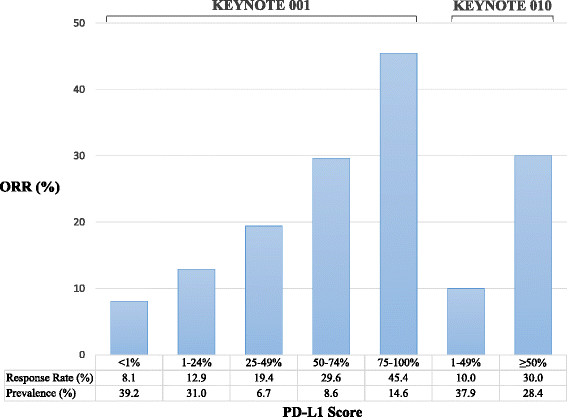PD-L1 biomarker testing for non-small cell lung cancer: truth or fiction?
- PMID: 27532023
- PMCID: PMC4986262
- DOI: 10.1186/s40425-016-0153-x
PD-L1 biomarker testing for non-small cell lung cancer: truth or fiction?
Abstract
Research in cancer immunology is currently accelerating following a series of cancer immunotherapy breakthroughs during the last 5 years. Various monoclonal antibodies which block the interaction between checkpoint molecules PD-1 on immune cells and PD-L1 on cancer cells have been used to successfully treat non-small cell lung cancer (NSCLC), including some durable responses lasting years. Two drugs, nivolumab and pembrolizumab, are now FDA approved for use in certain patients who have failed or progressed on platinum-based or targeted therapies while agents targeting PD-L1, atezolizumab and durvalumab, are approaching the final stages of clinical testing. Despite impressive treatment outcomes in a subset of patients who receive these immune therapies, many patients with NSCLC fail to respond to anti-PD-1/PD-L1 and the identification of a biomarker to select these patients remains highly sought after. In this review, we discuss the recent clinical trial results of pembrolizumab, nivolumab, and atezolizumab for NSCLC, and the significance of companion diagnostic testing for tumor PD-L1 expression.
Keywords: Biomarker; Immune checkpoint inhibitor; Immunotherapy; Lung cancer; NSCLC; Nivolumab; PD-1; PD-L1; Pembrolizumab.
Figures
Similar articles
-
The Next Immune-Checkpoint Inhibitors: PD-1/PD-L1 Blockade in Melanoma.Clin Ther. 2015 Apr 1;37(4):764-82. doi: 10.1016/j.clinthera.2015.02.018. Epub 2015 Mar 29. Clin Ther. 2015. PMID: 25823918 Free PMC article. Review.
-
Targeting the PD-1 pathway: a new hope for gastrointestinal cancers.Curr Med Res Opin. 2017 Apr;33(4):749-759. doi: 10.1080/03007995.2017.1279132. Epub 2017 Jan 31. Curr Med Res Opin. 2017. PMID: 28055269 Review.
-
Targeting the PD-1/PD-L1 axis in non-small cell lung cancer.Curr Probl Cancer. 2017 Mar-Apr;41(2):111-124. doi: 10.1016/j.currproblcancer.2016.12.002. Epub 2016 Dec 23. Curr Probl Cancer. 2017. PMID: 28214087 Review.
-
Companion and Complementary Diagnostics-Focus on PD-L1 Expression Assays for PD-1/PD-L1 Checkpoint Inhibitors in Non-Small Cell Lung Cancer.Ther Drug Monit. 2018 Feb;40(1):9-16. doi: 10.1097/FTD.0000000000000460. Ther Drug Monit. 2018. PMID: 29084031 Review.
-
Novel immunotherapy in the treatment of advanced non-small cell lung cancer.Expert Rev Clin Pharmacol. 2016 Dec;9(12):1571-1581. doi: 10.1080/17512433.2016.1236681. Epub 2016 Sep 23. Expert Rev Clin Pharmacol. 2016. PMID: 27623999 Review.
Cited by
-
Artificial intelligence in digital pathology - new tools for diagnosis and precision oncology.Nat Rev Clin Oncol. 2019 Nov;16(11):703-715. doi: 10.1038/s41571-019-0252-y. Epub 2019 Aug 9. Nat Rev Clin Oncol. 2019. PMID: 31399699 Free PMC article. Review.
-
Novel clinical and radiomic predictors of rapid disease progression phenotypes among lung cancer patients treated with immunotherapy: An early report.Lung Cancer. 2019 Mar;129:75-79. doi: 10.1016/j.lungcan.2019.01.010. Epub 2019 Jan 23. Lung Cancer. 2019. PMID: 30797495 Free PMC article.
-
Artificial Intelligence-Assisted Score Analysis for Predicting the Expression of the Immunotherapy Biomarker PD-L1 in Lung Cancer.Front Immunol. 2022 Jul 1;13:893198. doi: 10.3389/fimmu.2022.893198. eCollection 2022. Front Immunol. 2022. PMID: 35844508 Free PMC article.
-
Advancements in Human Breast Cancer Targeted Therapy and Immunotherapy.J Cancer. 2021 Oct 11;12(23):6949-6963. doi: 10.7150/jca.64205. eCollection 2021. J Cancer. 2021. PMID: 34729098 Free PMC article. Review.
-
PD-L1 and PD-1 and characterization of tumor-infiltrating lymphocytes in high grade sarcomas of soft tissue - prognostic implications and rationale for immunotherapy.Oncoimmunology. 2017 Nov 20;7(3):e1389366. doi: 10.1080/2162402X.2017.1389366. eCollection 2018. Oncoimmunology. 2017. PMID: 29399389 Free PMC article.
References
-
- Groome PA, Bolejack V, Crowley JJ, et al. The IASLC Lung Cancer Staging Project: validation of the proposals for revision of the T, N, and M descriptors and consequent stage groupings in the forthcoming (seventh) edition of the TNM classification of malignant tumours. J Thorac Oncol. 2007;2:694–705. doi: 10.1097/JTO.0b013e31812d05d5. - DOI - PubMed
Publication types
LinkOut - more resources
Full Text Sources
Other Literature Sources
Medical
Research Materials

